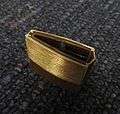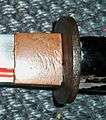Japanese sword mountings
Japanese sword mountings are the various housings and associated fittings (tosogu)[1] that hold the blade of a Japanese sword when it is being worn or stored. Koshirae (拵え) refers to the ornate mountings of a Japanese sword (e.g. katana) used when the sword blade is being worn by its owner, whereas the shirasaya is a plain undecorated wooden mounting composed of a saya and tsuka that the sword blade is stored in when not being used.


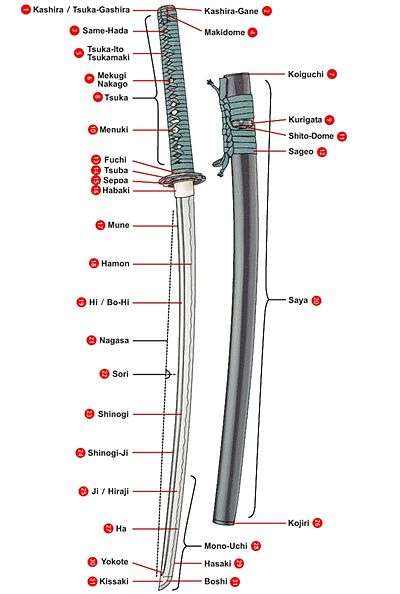
Components
- Fuchi (縁)': The fuchi is a hilt collar between the tsuka and the tsuba.
- Habaki (鎺): The habaki is a wedge shaped metal collar used to keep the sword from falling out of the saya and to support the fittings below; fitted at the ha-machi and mune-machi which precede the nakago.
- Kaeshizuno (返し角): a hook shaped fitting used to lock the saya to the obi while drawing.
- Kashira (頭): The kashira is a butt cap (or pommel) on the end of the tsuka.
- Kōgai (笄): The kōgai is a spike for hair arranging carried sometimes as part of katana-koshirae in another pocket.
- Koiguchi (鯉口): The koiguchi is the mouth of the saya or its fitting; traditionally made of buffalo horn.
- Kojiri (鐺): The kojiri is the end of the saya or the protective fitting at the end of the saya; also traditionally made of buffalo horn.
- Kozuka (小柄): The kozuka is a decorative handle fitting for the kogatana; a small utility knife fit into a pocket on the saya.
- Kurigata (栗形): The kuri-kata is a knob on the side of the saya for attaching the sageo.
- Mekugi (目釘): The mekugi is a small peg for securing the tsuka to the nakago.
- Menuki (目貫): The menuki are ornaments on the tsuka (generally under the tsuka-ito); to fit into the palm for grip and originally meant to hide the mekugi.
- Mekugi-ana (目釘穴): The mekugi-ana are the holes in the tsuka and nakago for the mekugi.
- Sageo (下げ緒): The sageo is the cord used to tie saya to the belt/obi when worn.
- Same-hada (鮫肌): literally the pattern of the ray skin.
- Same-kawa (samegawa) (鮫皮): same-kawa is the ray or shark skin wrapping of the tsuka (handle/hilt).
- Saya (鞘): The saya is a wooden scabbard for the blade; traditionally done in lacquered wood.
- Seppa (切羽): The seppa are washers above and below the tsuba to tighten the fittings.
- Shitodome (鵐目): an accent on the kurikata for aesthetic purposes; often done in gold-ish metal in modern reproductions.
- Tsuba (鍔 or 鐔): The tsuba is a hand guard.
- Tsuka (柄): The tsuka is the hilt or handle; made of wood and wrapped in samegawa.
- Tsuka-maki (柄巻): the art of wrapping the tsuka, including the most common hineri maki and katate maki (battle wrap). There are also more elaborate and artistic wrapping techniques, like Jabara maki.
- Tsuka-ito (柄糸): Tsuka-ito the wrap of the tsuka, traditionally silk but today most often in cotton and sometimes leather
- Wari-bashi (割箸): metal chop-sticks fit in a pocket on the saya
Shirasaya
A shirasaya (白鞘), "white scabbard",[2] is a plain wooden Japanese sword consisting of a saya (scabbard) and tsuka (hilt), traditionally made of nurizaya wood and used when a blade was not expected to see use for some time and needed to be stored. They were externally featureless save for the needed mekugi-ana[3] to secure the nakago (tang), though sometimes sayagaki (blade information) was also present. The need for specialized storage is because prolonged koshirae mounting harmed the blade, owing to factors such as the lacquered wood retaining moisture and encouraging corrosion.
Such mountings are not intended for actual combat, as the lack of a tsuba (guard) and proper handle wrappings were deleterious; as such they would likely never make their way onto a battlefield. However, there have been loosely similar "hidden" mountings, such as the shikomizue. Also, many blades dating back to earlier Japanese history are today sold in such a format, along with modern-day reproductions; while most are purely decorative replicas, a few have functional blades.[4]
Shirasaya gallery
 A typical shirasaya with sayagaki (attribution or appraisal written on a shirasaya)
A typical shirasaya with sayagaki (attribution or appraisal written on a shirasaya) Naginata shirasaya
Naginata shirasaya- Tanto shirasaya
- Wakizashi mounted in shirasaya
- Yari shirasaya
Koshirae
The word koshirae is derived from the verb koshiraeru (拵える), which is no longer used in current speech. More commonly "tsukuru" is used in its place with both words meaning to "make, create, manufacture." A more accurate word is tōsō (刀装), meaning sword-furniture, where tōsōgu (刀装具) are the parts of the mounting in general, and "kanagu" stands for those made of metal. Gaisō (外装) are the "outer" mountings, as opposed to tōshin (刀身), the "body" of the sword.
A koshirae should be presented with the tsuka (hilt) to the left, particularly in times of peace with the reason being that you cannot unsheathe the sword easily this way. During the Edo period, many formalized rules were put into place: in times of war the hilt should be presented to the right allowing the sword to be readily unsheathed.
Koshirae were meant not only for functional but also for aesthetic purposes, often using a family mon (crest) for identification.
Types of koshirae
Tachi
The tachi style koshirae is the primary style of mounting used for the tachi, where the sword is suspended edge-down from two hangers (ashi) attached to the obi.[5] The hilt often had a slightly stronger curvature than the blade, continuing the classic tachi increase in curvature going from the tip to the hilt. The hilt was usually secured with two pegs (mekugi), as compared to one peg for shorter blades including uchigatana and katana. The tachi style koshirae preceded the uchigatana (katana) style koshirae.
Uchigatana (katana)
The uchigatana style koshirae is the most commonly known koshirae and it is what is most associated with a samurai sword. Swords mounted in this manner are worn with the cutting edge up as opposed to the tachi mounting, in which the sword is worn with the cutting edge down.
Han-dachi (half tachi)
The han-dachi koshirae was worn katana-style but included some tachi related fittings such as a kabuto-gane instead of a kashira.
Aikuchi
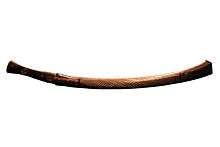
The aikuchi (合口 or 匕首) is a form of koshirae for small swords in which the hilt and the scabbard meet without a crossguard between them.[6] The word literally means ai ("meeting") + kuchi ("mouth; opening"), in reference to the way the hilt fits directly against the scabbard.[7][8] Originally used on the koshigatana (a precursor to the wakizashi) to facilitate close wearing with armour,[6][9] it became a fashionable upper-class mounting style for a tantō (literally, "small sword", nowadays regarded as a dagger) from the Kamakura period onwards.
Shikomizue
The shikomizue (仕込み杖, "prepared cane") or jotō (杖刀, "staff sword")[10] is a Japanese swordstick. It is most famous for its use by the fictional swordmaster Zatoichi. The sword blade was placed in a cane-like mounting (tsue) as concealment. These mountings are not to be confused with the Shirasaya (白鞘, "white scabbard"), which were just plain wooden mountings with no decoration other than (sometimes) a short description of the contents.
Some shikomi-zue also concealed metsubushi, chains, hooks, and many other things. Shikomi-zue could be carried in public without arousing suspicion, making them perfect tools for shinobi.
Kaiken
The kaiken is an 8–10 inch long, single- or double-edged dagger[11] without ornamental fittings housed in a plain mount, formerly carried by men and women of the samurai class in Japan. It was useful for self-defense indoors where the long katana and intermediate wakizashi were inconvenient. Women carried them in their kimono either in a pocket like fold or in the sleeve [12] for self-defense or for suicide by means of slashing the jugular veins and carotid artery in the left side of the neck.[13][14]
Koshirae gallery
 Tantō mounted in aikuchi style koshirae
Tantō mounted in aikuchi style koshirae Shikomizue koshirae
Shikomizue koshirae Tachi and tachi koshirae
Tachi and tachi koshirae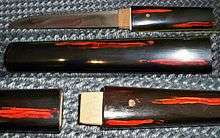 Kaiken (kwaiken) tanto
Kaiken (kwaiken) tanto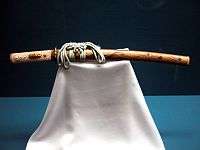 Wakizashi koshirae
Wakizashi koshirae Tanto koshirae
Tanto koshirae
Parts of the koshirae
Saya
Saya (鞘) is the Japanese term for a scabbard, and specifically refers to the scabbard for a sword or knife. The saya of a koshirae (scabbards for practical use) are normally manufactured from very lightweight wood, with a coat of lacquer on the exterior. The wood is light enough that great care must be taken when drawing the sword; incorrect form may result in the blade of the sword slicing through the saya and injuring one or more fingers. Correct drawing and sheathing of the blade involves contacting the mune (the back of the blade) rather than ha (the edge) to the inside of the scabbard. The saya also has a horn knob (栗形, kurigata) on one side for attaching a braided cord (sageo), and may have a shitodome (mounting loop) to accent the kurigata as well as an end cap (小尻, kojiri) made from metal. Traditionally the koiguchi (the throat of the scabbard) and kojiri (the chape) were made from buffalo horn.
 Katana saya
Katana saya- Naginata saya
 Tanto saya
Tanto saya Wakizashi saya
Wakizashi saya
The Saya is divided in parts:
- Sageo
A sageo (下緒 or 下げ緒) is a hanging cord made of silk, cotton or leather that is passed through the hole in the kurigata (栗形) of a Japanese sword's saya. There are a number of different methods for wrapping and tying the sageo on the saya for display purposes. Other uses for the sageo are tying the sword to the samurai and hojojutsu. The samurai felt the sageo formed a spiritual bond between them and the sword, and they were very particular about tying it correctly when the sword was not in use.[15]

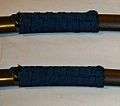 A matched set (daisho) of sageo
A matched set (daisho) of sageo
- Kuri-kata
The kurikata is a knob that is attached to the scabbard of a Japanese sword. The sageo (cord) that secures the saya of the sword to the obi (belt) goes through a hole in the kurikata.
- Kojiri
The kojiri is the end cap of the scabbard or the protective fitting at the end of the scabbard.
- Kogatana and kozuka
Kogatana, a small utility knife that fits into a pocket on the scabbard, the kozuka is the decorative handle for the kogatana.
- kōgai
The kōgai is a spike for hair arranging that fits into a pocket on the saya.
 Tanto koshirae showing a kōgai in its pocket
Tanto koshirae showing a kōgai in its pocket



- Umabari
The umabari is a small knife that is a variation of the kogatana, it fits into a pocket on the saya.
Tsuka
The tsuka is the hilt or handle of a Japanese sword.
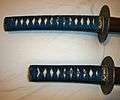 Two tsuka katana (top), wakizashi (bottom) in the form of a daisho (matched set)
Two tsuka katana (top), wakizashi (bottom) in the form of a daisho (matched set) Katana tsuka
Katana tsuka_tachi_tsuka.jpg) Tachi tsuka
Tachi tsuka- Wakizashi tsuka
 Tsuka constructed as a single piece and does not have individual separate fuchi, kashira, and menuki
Tsuka constructed as a single piece and does not have individual separate fuchi, kashira, and menuki
The tsuka is divided in the following parts:
- Menuki
The menuki are ornaments on the tsuka (generally under the tsuka-ito); to fit into the palm for grip.


 Tsuka with a menuki in the shape of standing goose with bamboo
Tsuka with a menuki in the shape of standing goose with bamboo
 Menuki with horse and rider
Menuki with horse and rider
- Samegawa
Samegawa is the ray skin used to cover or wrap the handle.

- Tsuka showing the samegawa
.jpg) Tanto tsuka showing the samegawa
Tanto tsuka showing the samegawa

- Tsuka-ito
Tsuka-ito is the wrapping of the tsuka, traditionally silk but today more often cotton and sometimes, leather.
- Fuchi
Fuchi, a cap type collar or ferrule which covers the opening in the tsuka of a Japanese sword. The tang of the sword goes into the tsuka through the opening in the fuchi.
- Katana fuchi
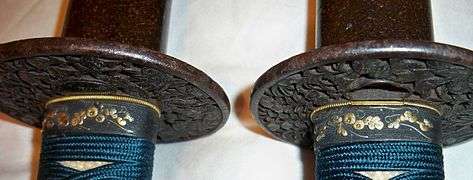 A daisho pair of fuchi
A daisho pair of fuchi Fuchi with dragon
Fuchi with dragon Fuchi with crouching lions
Fuchi with crouching lions
- Kashira
The kashira is the end cap (pommel) on the tsuka.
- Katana kashira
 Daisho kashira, wakizashi and katana
Daisho kashira, wakizashi and katana Kashira with samurai
Kashira with samurai Kashira with herons and reeds
Kashira with herons and reeds
Tsuba
The tsuba (鍔, or 鐔) is usually a round (or occasionally squareish) guard at the end of the grip of bladed Japanese weapons, like the katana and its various variations, tachi, wakizashi, tantō, naginata etc. They contribute to the balance of the weapon and to the protection of the hand. The tsuba was mostly meant to be used to prevent the hand from sliding onto the blade during thrusts as opposed to protecting from an opponent's blade. The chudan no kamae guard is determined by the tsuba and the curvature of the blade. The diameter of the average katana tsuba is 7.5–8 centimetres (3.0–3.1 in), wakizashi tsuba is 6.2–6.6 cm (2.4–2.6 in), and tantō tsuba is 4.5–6 cm (1.8–2.4 in).
During the Muromachi period (1333–1573) and the Momoyama period (1573–1603) Tsuba were more for functionality than for decoration, being made of stronger metals and designs. During the Edo period (1603–1868) there was peace in Japan so tsuba became more ornamental and made of less practical metals such as gold.
Tsuba are usually finely decorated, and nowadays are collectors' items. Tsuba were made by whole dynasties of craftsmen whose only craft was making tsuba. They were usually lavishly decorated. In addition to being collectors items, they were often used as heirlooms, passed from one generation to the next. Japanese families with samurai roots sometimes have their family crest (mon) crafted onto a tsuba. Tsuba can be found in a variety of metals and alloys, including iron, steel, brass, copper and shakudō. In a duel, two participants may lock their katana together at the point of the tsuba and push, trying to gain a better position from which to strike the other down. This is known as tsubazeriai (鍔迫り合い), lit. pushing tsuba against each other. Tsubazeriai is a common sight in modern kendō.
In modern Japanese, tsubazeriai (鍔迫り合い) has also come to mean "to be in fierce competition."
- Katana tsuba
 Katana tsuba
Katana tsuba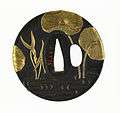 Lotus pond
Lotus pond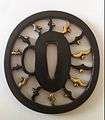 Shakudo tsuba - Chidori in flight.
Shakudo tsuba - Chidori in flight. Tsuba with autumn flowers
Tsuba with autumn flowers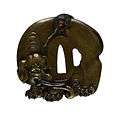 Tsuba with a monkey teasing an elephant with a stick
Tsuba with a monkey teasing an elephant with a stick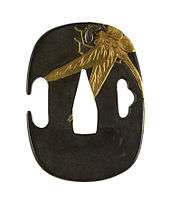 Tsuba with dragonfly in shibuichi
Tsuba with dragonfly in shibuichi
Seppa
The seppa are washers used in front of and behind the tsuba to tighten the fittings. Seppa can be ornate or plain.
- Tanto tsuba and two seppa
- Tanto tsuba and two seppa
- Yari tanto tsuba and two seppa
- Tsuba and two seppa
- Wakizashi tsuba and a single seppa
Habaki
The habaki (鎺) is a piece of metal encircling the base of the blade of a Japanese sword. It has the double purpose of locking the tsuba (guard) in place, and to maintain the weapon in its saya (scabbard).
The importance of the habaki is seen in drawing the katana from the scabbard. It is drawn by grasping the scabbard near the top and pressing the guard with the thumb to emerge the blade just enough to unwedge the habaki from inside the scabbard in a process called koiguchi no kirikata (鯉口の切り方) "cutting the koiguchi". The blade, being freed, can be drawn out very quickly. This is known as koiguchi o kiru (鯉口を切る), nukitsuke (抜き付け), or tanka o kiru (啖呵を切る) "clearing the tanka". This is obviously an extremely aggressive gesture, since a fatal cut can be given in a fraction of a second thereafter (see iaidō). It is similar in connotation and effect as drawing back the hammer of a handgun, chambering a round on a pump-action shotgun, or pulling back and releasing the charging handle on other firearms.
The expression "tanka o kiru" is now widely used in Japan, in the sense of "getting ready to begin something", or "getting ready to speak", especially with an aggressive connotation.
The habaki will cause normal wear and tear inside the scabbard, and either a shim or a total replacement of the scabbard may be needed to remedy the issue as it will become too loose over time. Removing the habaki and oiling it after cutting or once every few months is recommended.
See also
- List of National Treasures of Japan (crafts-swords)
- Tsuba in the collection of Wolverhampton Art Gallery, England
Notes
- The New Generation of Japanese Swordsmiths, Authors Tamio Tsuchiko, Kenji Mishina, Publisher Kodansha International, 2002, P.191&P.191 ISBN 978-4-7700-2854-9
- In this context, "white" could be inferred as plain or undecorated.
- Holes in the hilt, meant for the mekugi (pegs) that secure the blade (See katana).
- Most manufacturers will note that such mountings are only meant for storage, display and transport purposes, not actual usage.
- Art of the samurai: Japanese arms and armor, 1156–1868, Authors Morihiro Ogawa, Kazutoshi Harada, Publisher Metropolitan Museum of Art, 2009, ISBN 1-58839-345-3, ISBN 978-1-58839-345-6 P.193
- The Japanese sword,Kanzan Satō, Kodansha International, May 30, 1983 P.196
- 1988, 国語大辞典(新装版) (Kokugo Dai Jiten, Revised Edition) (in Japanese), Tōkyō: Shogakukan
- 2006, 大辞林 (Daijirin), Third Edition (in Japanese), Tōkyō: Sanseidō, ISBN 4-385-13905-9
- Samurai: The Weapons and Spirit of the Japanese Warrior, Clive Sinclaire, Globe Pequot, Nov 1, 2004 P.88
- Seishinkai Bujutsu. "Concealed and Trick Weapons". Archived from the original on July 28, 2014. Retrieved January 5, 2012.
- A Glossary of the Construction, Decoration and Use of Arms and Armor: In All Countries and in All Times, George Cameron Stone, Courier Dover Publications, 1999, ISBN 0-486-40726-8, ISBN 978-0-486-40726-5. p. 405.
- Samurai: The Weapons and Spirit of the Japanese Warrior, Clive Sinclaire, Globe Pequot, Nov 1, 2004 P.88
- The complete encyclopedia of arms & weapons: the most comprehensive reference work ever published on arms and armor, Claude Blair, Publisher Bonanza Books, 1986, ISBN 0-517-48776-4, ISBN 978-0-517-48776-1 P.306
- The sword book in Honchō gunkikō and The book of Samé, Kō hi sei gi of Inaba Tsūriō, Authors Hakuseki Arai, Tsūryū Inaba, Publisher C. E. Tuttle, 1963 P.42
- "The Sageo and How to Wear Your Katana". martialartsweaponstraining. Martial Arts Weapons and Training. August 6, 2017. Archived from the original on September 20, 2018.
References
- C. U. Guido Schiller. "Koshirae: Nihon Token Gaiso The Mountings of Japanese Swords". Archived from the original on 2008-07-04. Retrieved 2008-06-17.
Further reading
- The Craft of the Japanese Sword, Leon and Hiroko Kapp, Yoshindo Yoshihara ; Kodansha International; ISBN 0-87011-798-X
- The Samurai Sword: A Handbook, John M. Yumoto ; Charles E. Tuttle Company; ISBN 0-8048-0509-1
- The Japanese Sword, Kanzan Sato ; Kodansha International; ISBN 0-87011-562-6
- Japanese Swords, Nobuo Ogasawara ; Hoikusha Publishing Co, Ltd. ISBN 4-586-54022-2
External links
| Wikimedia Commons has media related to Tosogu (Japanese sword fittings). |
- History of the Development of Koshirae
- Habaki – On Japanese Swords
- Martial Arts Weapons and Training – The Sageo and How to Wear Your Katana
- Nihonto Antiques – Step by step guide to tying a Sageo (photos).
- Usagiya Sword Shop – Step by step guide to tying a Sageo (photos).
- TakumiWarrior Sword Shop – Exploration of Japanese Tsuba Designs (photos).






